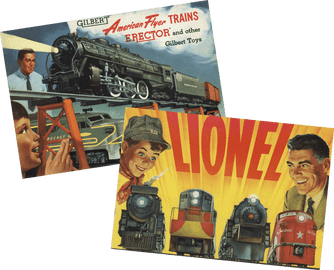 Toy trains appeared in Europe at least as far back as the 1840s - not that long after real railways began. These “carpet railways” were toy trains that ran on the floor sometimes powered by steam or clockwork but usually just pushed along by their youthful owners. There was no toy track until later in the 19th century. In America, cast iron floor trains were yery popular and often quite elaborate in detail. Some trains were made of wood with brightly colored lithograph detailing pasted on their sides. The first electric toy train sets were produced in the U.S. by the Carlisle and Finch Company slightly later than the first sets appeared in Europe. As the Twentieth Century got underway many firms began to produce elec- tric train sets, most importantly the Lionel Corporation of New York that had it’s beginning in 1901. Lionel’s chief competition came from the Ives manufacturing Company of Bridgeport Connecticut. Ives began in 1868. Among other products they made many popular cast iron and clockwork toy trains. After a fire destroyed the factory in 1900, Ives retooled and began producing clockwork trains that ran on sectional track in 1901. Lionel mostly stayed out of the clockwork train market and Ives’ major competition was from German companies such as Bing and Karl Bub among others. Ives did not produce electric train sets until 1910. They became the the larg- est U.S. toy train manufacturer until overtaken by Lionel in 1924. What is it that specifically links toy trains to the traditions of Christmas? Trains were a popular and relatively inexpensive toy in the last third of the 19th century as were toy sreamboats, dolls and cast iron toy cookstoves. The electric train set in the 20th Century proved to be a more elaborate and expensive plaything. A young boy might be lucky enough to receive one as a birthday gift but but probably, in most cases, his parents would likely reserve the purchase of a set of trains as a Christmas gift. But there is another tradition that toy trains fit into that predates the appearance of the railroad itself. In the early 1800s German immigrants settling in the U.S. brought many of their holiday traditions with them , most notably the Christmas tree. Another was the “Christmas Garden”. This grew out of the Nativity scene or creche that was a set of miniature figures representing the Holy Family and the associated animals, shepherds and wise- men enacting the Christmas story. These go back to the Rennaisance (although Nativity scenes featuring live participants were staged by St. Francis). In Europe these little tableaux became, over the years, supplemented by other figures and buildings growing into a miniature village. The Moravians brought this tradition to America and referred to them as “putzes”. These little villages or “Christmas Gardens” were often set up beneath the Christmas tree. It’s easy to see how the toy electric or clockwork train set with it’s basic circle of track running around the tree logically became a part of the fabric of the Christmas Garden. The inclusion of a set of trains under the tree became a standard feature of American Christmas culture, appearing in illustrations in books and magazine ads , holiday retail shop window displays and later, the movies. The train set and miniature village became a part of decorating for the holidays and was often dismantled and put away until next yeat when the tree was taken down after the New Year. The toy train companies adroitly catered to this holiday connection that provided the year’s greatest sales but also had their sights on a year-long marketing experience. A wide array of accessories and add-ons to the basic train set such as signals, crossing signs and gates, track switches, model buildings, new locomotive models and rolling stock were available. This engendered the concept of a permanent toy train layout that made for an on-go- ing hobby and not just a circle of track around the Christmas tree. By encouraging this “add-on mentality” the toy train manufactures kept their business going all year and offered new gift possibilities on subsequent years and at occaisions other than the holidays. The toy companies, Lionel chiefly among them, aggresively marketed their product lines to boys and their fathers. Lionel and Ives often ran full-page advertisements in national magazines as the holidays approached and Lionel even had it’s own radio show. In the post-World War II era both Lionel and American Flyer reached out to the swelling market of baby boomers via the new medium of television. The time-honored and perhaps most fondly remembered marketing tools were the yearly catalogs. Slick, color- ful, usually in landscape format in order to best show off the new train sets, these catalogs were eagerly awaited and constantly poured over by hopeful kids eager for a new train set or something new as an add-on to their existing “pike”. Like the Christmas tree and garden, those catalogs were a big part of the holiday , fostering antic- ipation and were a big part of the lead-up to the holiday season. Stacks of them were given out for free at depart- ment store displays. hobby shops and hardware stores; everywhere trains were on sale. While the father and son conection was a big part of the companies’ marketing , as the two were often featured on the covers of the catalogs and ads, girls were always marginalized; sometimes depicted but never in the fore- front and never shown operating the trains. Seeing the young ladies as a potential untapped market, in 1957 Li- onel made a foray into no-man’s land with the “Lady Lionel” train set. Drawing a string of “fashion-right” pastel colored freight cars was a pink locomotive and tender. A transformer cased in white with gold trim was packed with this condescending disaster. Few were sold and ironically sets tht have survived have proven to be hot baby boomer collectables along side Mickey Mantle baseball cards and “Forbidden Planet” movie posters. While this set has been reproduced for modern-day collectors it is doubtful that many girls back in the 50s would have pre- ferred this bizarre concept to that of a normal looking train set that represented something they could relate to. Stay tuned for Part 2: Train Wars!
0 Comments
Leave a Reply. |
Get to know us!Here's where we post new products, stuff we want to share, and the occasional joke. Archives
September 2017
Categories
All
|

 RSS Feed
RSS Feed
